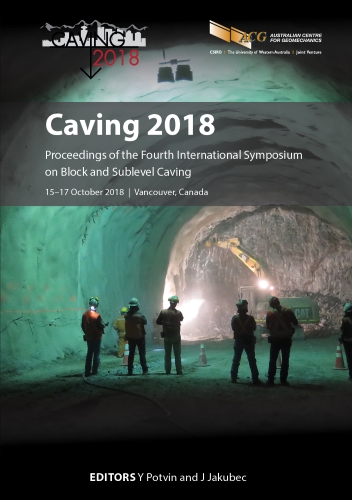Towards physics-based hazard assessment tools for developing blanket re-entry rules

|
Authors: de Beer, W; Smith-Boughner, L; Viegas, G; Bosman, K; Angus, D |
DOI https://doi.org/10.36487/ACG_rep/1815_42_de_Beer
Cite As:
de Beer, W, Smith-Boughner, L, Viegas, G, Bosman, K & Angus, D 2018, 'Towards physics-based hazard assessment tools for developing blanket re-entry rules', in Y Potvin & J Jakubec (eds), Caving 2018: Proceedings of the Fourth International Symposium on Block and Sublevel Caving, Australian Centre for Geomechanics, Perth, pp. 545-552, https://doi.org/10.36487/ACG_rep/1815_42_de_Beer
Abstract:
Hazard assessment tools are often classified as either purely probabilistic or deterministic. Probabilistic assessments utilise the statistics of past occurrences to attempt a forecast, with suitable confidence levels, of future occurrences in a given spatial volume and time frame. Purely deterministic methods use constitutive equations, equations of state, or equations of motion to extrapolate future behaviour. In this paper, we report on initial work towards deterministic assessments by compiling the statistics of the behaviour of physical variables based on seismic source parameters, and rock mass stress state and condition inferred from seismic velocities for comparison to the occurrence of significant events and/or damage at particular locations in mines. At this stage, we only report on whether patterns and statistics may exist.
Keywords: passive seismic tomography, seismic velocity, seismic time series
References:
Aki, R & Richards, PG 2002, Quantitative Seismology, 2nd edn, University Science Books, Sausalito.
Crowley, JW, Baig, AM, Urbancic, TI & von Lunen, E 2015, ‘4D tomography and deformation from microseismic data’, Proceedings of the 85th Annual Meeting of the Society of Exploration Geophysics, Society of Exploration Geophysicists, Tulsa.
Malek, F & Leslie, IS 2006, ‘Using seismic data for rockburst re-entry protocol ant INCO’s Copper Cliff North Mine’, in D Yale, S Holtz, C Breeds & U Ozbay (eds), Proceedings of the 41st Symposium on Rock Mechanics: 50 Years of Rock Mechanics – Landmarks and Future Challenges, American Rock Mechanics Association, Alexandria.
Mendecki, AM 1996, Quantitative Seismology in Mines, Springer, Basel.
Niu, F, Silver, PG, Daley, TM, Cheng, X & Majer, EL 2008, ‘Preseismic velocity changes observed from active source monitoring at the Parkfield SAFOD drill site’, Nature, vol. 454, pp. 204–208.
Rawlinson, N & Sambridge, M 2003, ‘Seismic traveltime tomography of the crust and lithosphere’, Advances in Geophysics, vol. 46, pp. 81–198.
Rawlinson, N & Sambridge, M 2005, ‘The fast marching method: an effective tool for tomographic imaging and tracking multiple phases in complex layered media’, Exploration Geophysics, vol. 36, pp. 341–350.
Silver, PG, Daley TM, Niu F & Majer, EL 2007, ‘Active source monitoring of crosswell seismic travel time for stress-induced changes’, Bulletin of the Seismological Society of America, vol. 97, no. 1, 281–293.
Vallejos, JA & McKinnon, SD 2011, ‘Correlations between mining and seismicity for re-entry protocol development’, International Journal of Rock Mechanics and Mining Sciences, vol. 48, no. 4, pp. 616–625.
Yamamura, K, Sano, O, Utada, H, Takei, Y, Shigeru, N & Fukao, Y 2003, ‘Long-term observation of in situ seismic velocity and attenuation’, Journal of Geophysical Research, vol. 108, pp. 2317–2331.
© Copyright 2025, Australian Centre for Geomechanics (ACG), The University of Western Australia. All rights reserved.
View copyright/legal information
Please direct any queries or error reports to repository-acg@uwa.edu.au
View copyright/legal information
Please direct any queries or error reports to repository-acg@uwa.edu.au
